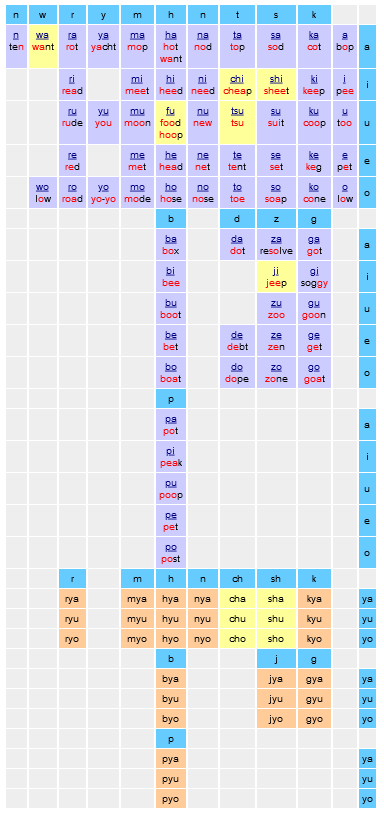Japanese Language Pronunciation


- Reading order – the table above should be read in the following order:
- read each a, i, u, e, o basic Japanese sound section from top to bottom and then from right to left:
- ie: a i u e o ka ki ku ke ko
- then read each ya, yu, yo combination Japanese sound section from top to bottom and then from right to left:
- ie: kya kyu kyo
- Basic Japanese sounds – each colored cell of the table contains a Japanese sound written in romaji, ie: ka . The Basic Japanese sounds are combined with English words to show the pronunciation of each sound. The romaji sound a is pronounced the same as o in the English word bop . Additional examples:
- ie: k + a = ka = cot ( co is the pronunciation of ka )
- ie: n + u = nu = new ( new is the pronunciation of nu )
- ie: r + o = ro = road ( roa is the pronunciation of ro )
- ie: w + a = wa = want ( wa is the pronunciation of wa )
- Combination Japanese sounds – to form these sounds, pick a consonant from any of the horizontal rows (blue) at the top of each ya, yu, yo section and a ya, yu, yo sound from the vertical row (blue) on the right. Use the same pronunciation as the Basic Japanese sounds when making these combinations. Note: there are no English equivalents for the combination sounds, as keeya and nyou are not English words:
- ie: k + ya = kya = ki + ya = keep + yacht = keeya
- ie: n + yu = nyu = n + yu = ten + you = nyou
- Exceptions
- shi , chi , tsu , ji – see each example in the table
- tsu is pronounced as in the borrowed Japanese word tsunami
- fu – two ways to pronounce – fu, hu
- ha – two ways to pronounce – ha, wa
- sha , shu , sho , cha , chu , cho – all pronounce the “y” sound but drop the “y” when writing in romaji
- Sound equivalents – each sound has a romaji and a hiragana and a katakana sound equivalent:
- ie: sound “bop” = romaji “a” = hiragana あ = katakana ア

